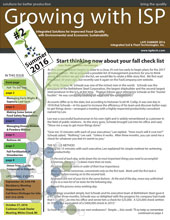

ReStore 3G offers an array of benefits, all of which work to preform exactly what the product name implies … to aid in restoring, or improving, soil vitality. It contains high levels of both humic and fulvic acids, bio-ferments, carbohydrates, penetrants, and fungal extracts including an assortment of dormant CFU’s (colony forming units) of beneficial fungal species. It is recommended to be applied at a rate of 3 gallons per acre and is particularly effective for preparing your soil for winter.
We included this application as part of the “Fall Check-List”. Once the product is activated by coming into contact with soil, it begins to perform several key functions including not only the addition of beneficial fungal species, but also providing an immediate food source for these organisms as well. Most of our crop production soils tend to be more bacterial than fungal. While this is somewhat desirable and natural, increasing the ratio of fungi to bacteria will produce many benefits.
Fungi are microscopic cells that usually grow as long threads or strands called hyphae, which push their way between soil particles, roots, and rocks. Hyphae are usually only several thousandths of an inch (a few micrometers) in diameter. A single hyphae can span in length from a few cells to many yards. A few fungi, such as yeast are single cells.
Hyphae sometimes group into masses called mycelium or thick, cord-like “rhizormorphs” that look like roots. Fungal fruiting structures (mushrooms) are made of hyphal strands, spores, and some special structures like gills on which spores form. An individual fungus can include many fruiting bodies scattered across an area as large as a baseball diamond.
Fungi perform important services related to water dynamics, nutrient cycling, and disease suppression. Along with bacteria, fungi are important as decomposers in the soil food web. They convert hard-to-digest organic material into forms that other organisms can use. Fungal hyphae physically bind soil particles together, creating stable aggregates that help increase water infiltration and soil water holding capacity.
According to numerous sources discussing soil biology, soil fungi is classified into three primary groups: Decomposers: saprophytic fungi – convert dead organic material into fungal biomass, carbon dioxide (CO2), and small molecules, such as organic acids. These fungi generally use complex substrates, such as the cellulose and lignin, in wood, and are essential in decomposing the carbon ring structures in some pollutants. A few fungi are called “sugar fungi” because they use the same simple substrates as do many bacteria. Like bacteria, fungi are important for immobilizing, or retaining, nutrients in the soil. In addition, many of the secondary metabolites of fungi are organic acids, so they help increase the accumulation of humic-acid rich organic matter that is resistant to degradation and may stay in the soil for hundreds of years.
Mutualists: develop mutually beneficial relationships with plants. Mycorrhizal fungi are the best known, and grow inside plant roots. Arbuscular mycorrhiza (VAM) are the most common, especially in agricultural plant associations. These fungi have arbuscles, growths formed inside the plant root that have many small projections into root cells, as well as their hyphae outside the root. This growth pattern increases the plant’s contact with the soil, improving access to water and nutrients, particularly phosphorus, while their mass of hyphae protects roots from pests and pathogens.
Pathogens: (including the well known verticillium, Phytophthora, Rhizoctonia & Phthium fungi) penetrate the plant and decompose the living tissue, leading to weakened or dead plants. Where disease symptoms are seen, the pathogenic fungi is usually the dominant organism in the soil. Soil with high biodiversity can suppress soil-borne fungal diseases.
In addition, both he fungi and bacteria will aggressively decompose any crop, or hydrocarbon, residues from the previous season. This aids in reducing potential sites for over-wintering by both disease and insect species. Of course, it also aids in any nutrient content being recycled into the nutrient pool for future crop growth.
Although designed for more high value crops such as produce, ReStore 3G is also used by a number of row crop farms. Reports have included much improved tillage (“ground works better”), better water/rainfall penetration, more rapid degradation of corn residue, and a significant reduction of “free” sodium and/or fertilizer salts.
